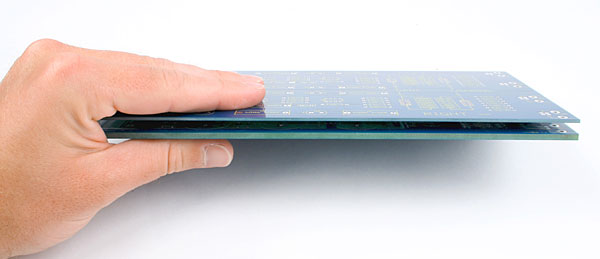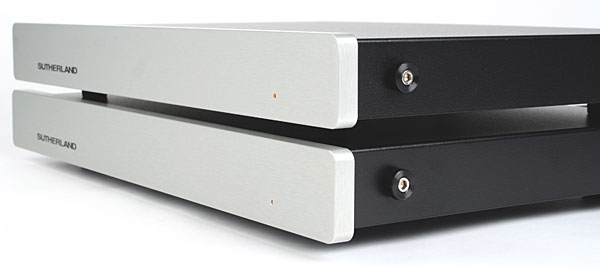| Columns Retired Columns & Blogs |
If I had the dosh, this would be the phono preamp to own!
Really great to hear your observations and comparisons were very lucid and communicative.
The Duos' superb resolution of detail was also not entirely in line with that of its siblings. I've found previous Sutherlands to be sublimely understated in their reproduction of detail. A better description of how the Duo sounded in this regard would be striking. The more obvious bits were much more vividly portrayed by the Duo than I've come to expect from Sutherland preamps. In this regard, the Duo sounded more like other A-list components. In that wider context, the Duo was far more sophisticated in how it handled low-level and inner detail. But compared to other Sutherlands, the Duo sometimes seemed to gloss over some of the subtleties that make Sutherland preamps so captivating.
Next up was the Duo's overall tonal balance, which I think of as the combination of frequency response, the timbres of instruments and voices, and how their transient characteristics vary with frequency. The first of these was easy: I heard nothing that suggested that the Duo's frequency response was anything other than flat. But it's the other two criteria that determine a component's overall tonal balance. Sutherland preamps have occasionally been described as having a rolled-off high end, or as lacking power on the bottom, criticisms I've understood but haven't shared. In the case of the Duo, debates about either are moot.

The piccolos in Fritz Reiner and the Chicago Symphony's recording of Prokofiev's Lieutenant Kije (LP, RCA Living Stereo LSC-2150/Chesky RC10) provided a good test of the Duo's top end. There was absolutely no lack of extension, but more significant, the piccolos highlighted how well the Duos' maintained their pitch definition and their portrayal of the instruments' timbre well into the upper treble. The Duos nailed the surprising way a piccolo's power and projection can increase with frequency, and such details as the sound of the player's breath moving across the mouthpiece were spot on, even at the highest frequencies. At the other frequency extreme, my listening made it clear that the Duos' low end was as extended as my listening room would support, and as powerful as required by any recording I've heard.
I've never heard any criticism of a Sutherland phono stage's midrange and I have none to offer here. Each instrument and voice had exactly the right balance of fundamental and harmonics, and the harmonic structures were complex and rich. One example of its superb sound in this regard was its reproduction of Suzanne Vega's voice in "Tom's Diner," an cappella recording from her Solitude Standing (LP, A&M SP 5136). Through the Duos, the combination of her odd rhythms and widely varying pitches and dynamic transients had me, hook, line, and sinker.
The last aspect of the Duo's sound I focused on was its reproduction of dynamic transients—which, in a well-set-up analog system, will largely be controlled by the phono preamp. In the past, some Sutherland preamps have been characterized as having somewhat foreshortened dynamic transients, and in some instances, this was true of the Duo. If a piece's largest dynamic transient ranged from pppp to ffff with the preamps I compared to the Duo, with the Duo it ranged from pppp to fff.
The size and impact of the Duo's reproduction of dynamic transients weren't at all deficient. In most cases, they were probably more representative of what I hear at a live performance, if less spectacular than those from preamps whose very raison d'àtre is creating explosive dynamic transients. The recording that for me best highlighted the difference was, oddly enough, one made in a studio. It was easy to hear the difference between transients that seemed natural and those that were spectacular in "Under the Boardwalk," from Rickie Lee Jones's Girl at Her Volcano (10" EP, Warner Bros. 23805-1 B). The dynamic transients in this track lacked for nothing through the Duo, and seemed just right.
When I thought about the speed rather than the size of the Duo's dynamic transients, the terms that came to mind were quick and lighter touch. I describe the Duo's transients as quick rather than fast because I reserve the latter adjective for components that sound fast but make the music feel edgy and rushed. The Duo's transients seemed ever-so-slightly ahead of the change in level or pitch, pulling the music along with just the correct amount of impulsion to support the music's natural flow.
The word that appears over and over in the notes from my sessions with the Duos is articulate. The more I listened, the more I was convinced that that word nails it. Consider Al Di Meola, John McLaughlin, and Paco de Luc°a's Friday Night in San Francisco (Half-Speed Mastered LP, Columbia HC 47152): The first cut in particular, "Mediterranean Sundance/Rio Ancho," was a killer example of how cleanly and precisely the Duos could portray dynamic transients. With lesser preamps, the notes played by Di Meola and/or de Luc°a will be blurred across one or more narrow frequency ranges. With the Duos, each note in the blistering exchanges between the guitarists started and stopped sharply, regardless of the pitch, volume, or complexity of the transient itself.
The Last Threshold to Cross
It would have been impossible to audition the Sutherland Duo without addressing the $6000 question: How did the $4000 Duo compare to the $10,000 PhonoBlock?
In some respects, the Duo sounded as one would expect: like a slightly detuned version of the PhonoBlock, reflecting compromises made to meet a lower price point. In other ways, it was a horse of a different color, suggesting that by the end of the development cycle, its trajectory may have shifted a bit.
The Duos definitely had the unique "revealed, not re-created" soundstage I've heard in all Sutherlands. Compared to preamps from other manufacturers, it was absolute. Compared to the PhonoBlocks, not quite. Solos and lead parts were slightly overemphasized through the Duos, and in many instances projected slightly forward from their surroundings. Similarly, the Duo's purity and lack of electronic detritus were breathtaking, and put it head and shoulders above the competition. The PhonoBlock was above the Duo, just not head and shoulders above it.

The same thing was true for other elements of the Duo's performance: significantly better than most other preamps, but not quite at the PhonoBlock's level. One example was the amount and complexity of subtle details; another was the Duo's ability to distinguish between slight shadings in any of music's five basic elements. Still another was how well the Duo portrayed the timbres and dynamics of instruments across the entire audioband. The Duo matched or bested anything I've heard in these areas, other than the PhonoBlock itself.
On the Duo's side of the tally were a number of pluses, mostly in those areas where some have been critical of earlier Sutherland preamps, including the PhonoBlock. The Duo's top end seemed more extended, and its bass had more power and impact. Edges of images were more sharply defined with the Duos, which made them more three-dimensional and seemingly tangible. The space between those images were more open, giving me a more convincing impression of being able to walk into it than I'd had with the PhonoBlocks.
I heard similar things when I compared the Duo's and PhonoBlock's transient performances. Dynamic transients sounded larger with the Duo, as well as faster, cleaner, and more precise. The PhonoBlock's transients, on the other hand, seemed more integral components of the music, and thus more natural. The Duo's sound had more energy; the PhonoBlock's was much closer to what I hear at a live performance.
We have arrived and enlightenment is ours.
With the Duo, Ron Sutherland has once again increased Sutherland Engineering's ratio of performance to price. In 2007, the PhonoBlock was ridiculously inexpensive compared to other phono preamps of similar sound quality. In 2017, the Duo is even more so. For starters, it comes very close to matching the PhonoBlock's performance while costing $6000 less per pair. In some areas, the Duo's sound even counters the criticisms levied against earlier Sutherland models, including the PhonoBlock. I wouldn't be at all surprised if listeners who highly value these areas actually prefer the Duo, regardless of price.
I'm concerned that, sandwiched as it is between Sutherland's incredible flagships and less-expensive giant-killer models, the Duo might be overlooked. If it is, that would be a sad state of affairs. The Duo is an incredible product. Given the attention it deserves, it might well become as much a classic as the original PhD.
I can't recommend the Sutherland Duo more highly. Listeners who can afford it should own a pair. Those who can't justify spending $4000 on a stereo phono preamp should think again. The fortunate few who own more expensive preamps need to find a place to hear them—a place that takes trade-ins.

If I had the dosh, this would be the phono preamp to own!
Really great to hear your observations and comparisons were very lucid and communicative.

Hi
I thoroughly enjoyed your review and concise description of the Sutherland Duo. I am leaning towards purchasing one, but my dealer is nudging me towards the Gold Note 10. Can you comment on the Gold Note?
I currently own the Zesto Audio 1.2 but I am finding a bit too much tube noise when I feed it through my Prima Luna HP Integrated.
I appreciate any suggestions you may have.
Thanks
Read more at https://www.stereophile.com/comment/reply/237010#TJCeKvcQ6I4KfHd9.99

Do you ground the turntable to both of the DUO's or just one?

I recently upgraded my Sutherland 20/20 to the DUO LPS.
Please update your review of the DUO ASAP, you won’t be sorry.

Great Review. Thanks!
Certainly The Duo is an incredible product.
My whole analogue system sounds better, my Soundsmith cartridge, my Nottingham turntable, my Origin Live tonearm, all have better affinity with my ML No.326S preamp. Now it is more transparent, with a balanced tonality, airy and extended, open and so smooth. Better!